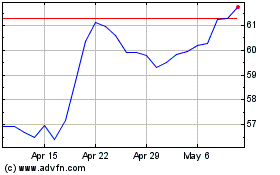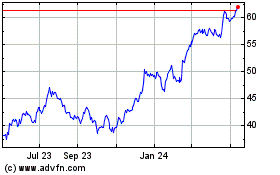Fed Approves Wells Fargo's Capital Plan -- Update
June 29 2016 - 7:21PM
Dow Jones News
By Emily Glazer
The Federal Reserve approved Wells Fargo & Co.'s capital
plan in the regulator's annual stress test released Wednesday.
Wells Fargo's plan was approved after the Fed found that the
largest U.S. bank by market value could keep lending in a severe
economic downturn. The approval clears the way for the San
Francisco-based firm to reward investors by returning capital --
either through dividend payouts or buying back stock, or both.
The bank later in the day reiterated its previously disclosed 38
cent dividend and didn't give any update on share repurchases.
The bank, along with several others, is expected to unveil plans
on its quarterly dividend and share repurchase activity later in
the day.
At the low point of a hypothetical recession, Wells Fargo's
common equity Tier 1 ratio -- which measures high-quality capital
as a share of risk-weighted assets -- would be 6.1%, above the 4.5%
level the Fed views as a minimum. The new ratio, unlike the one
reported last week by the Fed in a related test, takes into account
the bank's proposed capital plan.
Wells Fargo's Tier 1 leverage ratio, which measures high-quality
capital as a share of all assets, would have reached as low as 5.8%
in a hypothetical recession, above the 4% Fed minimum.
The latest stress-test result incorporates quantitative factors
assessed in data released by the Fed last week. These included a
simulation of how the bank's capital buffers would hold up under a
world-wide recession. The Fed's "severely adverse" scenario of
financial stress this year included a 10% U.S. unemployment rate,
significant losses in corporate and commercial real-estate lending
portfolios, and negative rates on short-term U.S. Treasury
securities.
This second-part of the test also included a qualitative
assessment by the Fed of a bank's capital-planning process and
internal controls. The Fed has the ability to object to a bank's
capital plan on either quantitative or qualitative grounds.
The Fed's Wednesday results are arguably the more important part
of the stress-test process since it dictates how much capital will
be returned to shareholders. Increased dividends and buybacks can
help to bolster a bank's share price.
Wells Fargo also passed last year but certain capital and
leverage results were down more than 0.5 percentage points from its
year-earlier results.
Bernstein bank analyst John McDonald wrote in a June note that
banks including Wells Fargo are "less likely to be viewed as
relative winner since they have less room for upside -- either
because they are already at the higher end of distributions, they
already announced dividend increases recently, and/or they have a
practice of not disclosing their buyback authorizations."
But, he wrote, Wells Fargo is among the U.S. banks expected to
have the highest total payout and dividend yields.
Wells Fargo has doled out much higher dividends and buybacks
than other big banks, making it more attractive for investors. For
example, Wells Fargo paid out dividends and bought back stock equal
to 75% of its net income last year. Bank of America Corp. was at
about 31%, while Citigroup Inc. was around 36%. Wells Fargo
recently raised its dividend to 38 cents a quarter, higher than
before the financial crisis.
Wells Fargo has also expanded more than 37% since it bought
Wachovia in 2008, taking on assets and adding new businesses to its
core Main Street franchise of lending and deposits.
Most notably, Wells Fargo last year agreed to scoop up parts of
the finance arm of General Electric Co., a unit that was unwinding
as a precaution against tighter regulations on big banks. It is the
third-biggest U.S. bank by assets now.
But it hasn't been all smooth sailing. The bank was the only one
flagged for "material errors" in its submission of the "living
wills," where regulators weigh in on banks' plans for navigating a
potential bankruptcy. In April, regulators said the bank needed to
significantly revise its plan, a surprise in part because the last
time regulators tackled this issue they said Wells Fargo was the
sole bank to lay out a viable bankruptcy path.
Write to Emily Glazer at emily.glazer@wsj.com
(END) Dow Jones Newswires
June 29, 2016 19:06 ET (23:06 GMT)
Copyright (c) 2016 Dow Jones & Company, Inc.
Wells Fargo (NYSE:WFC)
Historical Stock Chart
From Mar 2024 to Apr 2024

Wells Fargo (NYSE:WFC)
Historical Stock Chart
From Apr 2023 to Apr 2024
